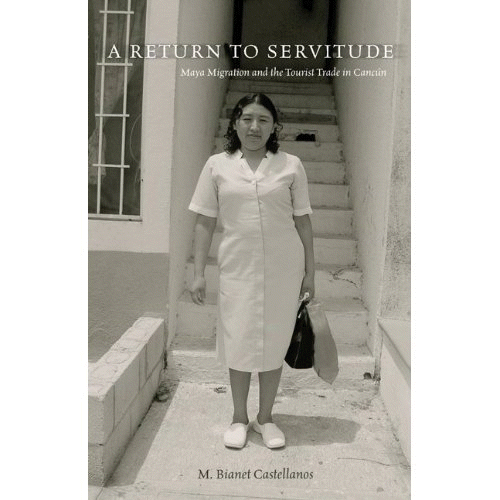To Servitude
Maya Migration and
The Tourist Trade in Cancún
M. Bianet Castellanos
(University of Minnesota)

Rather, she is one who digs in with the real people: in this case, Mayans who live in the village of Kuchmil, a day's ride from Cancún.
She moves into a mud flat to live with the family, bringing a few possession (notebook, a change of clothes, a few personal items.) She eats what they eat (beans, tortillas, rice), sleeps where they sleep (straw bed, hammock, floor), passes days without electricity, immersed in the buggy world of the Yucatan, even catches their diseases (and almost dies.)
She is trying to see their lives as they see their lives, and she's a honorable and resolute student ... sweating, swatting mosquitoes, helping to carry water, observing.
Castellanos began this project fifteen years ago. Her main study was how tourism touches on the Mayans, and Servitude makes us all observers. We tourists with our $5 margaritas and straw hats and funny tee-shirts that say "Cancún is for Lovers!" or "I Cancún Too" get to see --- intimately --- the world of the people who wash our clothes, clean our hotel rooms, serve our meals, fix our drinks.
For example, there is what Castillanos calls "commodification."
- Through the imposition of uniforms, specific ideas about gender and race, and standards of hygiene, beauty and disposition, the service industry [has] commodified workers' bodies.
It is the female workers who are most affected. "Women are relegated to work as waitresses on the beach and in the pool area because they provide the guests with a 'visual attraction' that enables them to sell more liquor than male waiters."
- Miniskirts that 'showed off their legs,' makeup and a 'flirtatious' attitude constituted the uniform and persona waitresses were required to don as they wandered the beach selling refreshments and liquor.
Passivity was the object. Employers preferred true Mayans, because there was, the author tells us, a presumption that "indigenous peoples" are naturally "docile, servile, and childlike, characteristics sought after in the service industry."
Ms. Castellanos writes, "A Return to Servitude considers the foundational roles indigenous peoples have played in the development of tourist, transnational spaces, and the modern nation-state."
- Spanning a period of fifteen years, it is based on an ethnography of a Maya community's migration experiences to Mexico's most popular tourist city.
In some of her most fascinating chapters, Castellanos delves into the traditions of the near-by village of Kuchmil ... the customs and the language, family roles and the effect of their "migrations." Migration, she tells us, has become a new "life stage in addition to marriage and parenthood."
- Migration in Mexico has become part of the rural experience, making the ciudad central to the rural image, not only as a foil to the rural but also as an expanded sense of place.
This is a fine book, and the author (and I) would appreciate the irony of your taking it along with you on your next visit to the Yucatan. Perhaps to nibble on a bit between your next serving of shrimp and tequila there on the beach. With it, you'd know exactly how you are changing the lives of the unseen workers right there in front of your eyes.